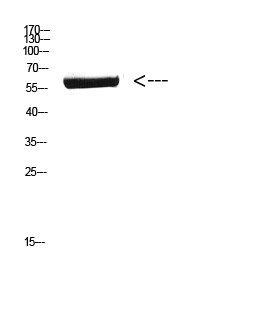CYP26B1 Polyclonal Antibody
- 产品详情
- 实验流程
- 背景知识
Application
| WB, E |
|---|---|
| Primary Accession | Q9NR63 |
| Reactivity | Human, Mouse, Rat |
| Host | Rabbit |
| Clonality | Polyclonal |
| Calculated MW | 57513 Da |
| Gene ID | 56603 |
|---|---|
| Other Names | CYP26B1 CYP26A2 P450RAI2 |
| Dilution | WB~~WB 1:500-2000, ELISA 1:10000-20000 E~~N/A |
| Format | Liquid in PBS containing 50% glycerol, 0.5% BSA and 0.09% (W/V) sodium azide. |
| Storage Conditions | -20℃ |
| Name | CYP26B1 |
|---|---|
| Synonyms | CYP26A2, P450RAI2 |
| Function | A cytochrome P450 monooxygenase involved in the metabolism of retinoates (RAs), the active metabolites of vitamin A, and critical signaling molecules in animals (PubMed:10823918, PubMed:22020119). RAs exist as at least four different isomers: all-trans-RA (atRA), 9-cis- RA, 13-cis-RA, and 9,13-dicis-RA, where atRA is considered to be the biologically active isomer, although 9-cis-RA and 13-cis-RA also have activity (Probable). Catalyzes the hydroxylation of atRA primarily at C-4 and C-18, thereby contributing to the regulation of atRA homeostasis and signaling (PubMed:10823918). Hydroxylation of atRA limits its biological activity and initiates a degradative process leading to its eventual elimination (PubMed:10823918, PubMed:22020119). Involved in the convertion of atRA to all-trans-4-oxo-RA. Can oxidize all-trans-13,14-dihydroretinoate (DRA) to metabolites which could include all-trans-4-oxo-DRA, all-trans-4-hydroxy-DRA, all-trans-5,8- epoxy-DRA, and all-trans-18-hydroxy-DRA (By similarity). Shows preference for the following substrates: atRA > 9-cis-RA > 13-cis-RA (PubMed:10823918, PubMed:22020119). Plays a central role in germ cell development: acts by degrading RAs in the developing testis, preventing STRA8 expression, thereby leading to delay of meiosis. Required for the maintenance of the undifferentiated state of male germ cells during embryonic development in Sertoli cells, inducing arrest in G0 phase of the cell cycle and preventing meiotic entry. Plays a role in skeletal development, both at the level of patterning and in the ossification of bone and the establishment of some synovial joints (PubMed:22019272). Essential for postnatal survival (By similarity). |
| Cellular Location | Endoplasmic reticulum membrane {ECO:0000250|UniProtKB:O43174}; Peripheral membrane protein {ECO:0000250|UniProtKB:O43174}. Microsome membrane {ECO:0000250|UniProtKB:O43174}; Peripheral membrane protein {ECO:0000250|UniProtKB:O43174} |
| Tissue Location | Highly expressed in brain, particularly in the cerebellum and pons. |
For Research Use Only. Not For Use In Diagnostic Procedures.
Provided below are standard protocols that you may find useful for product applications.
BACKGROUND
Involved in the metabolism of retinoic acid (RA), rendering this classical morphogen inactive through oxidation. Involved in the specific inactivation of all-trans-retinoic acid (all-trans-RA), with a preference for the following substrates: all-trans-RA > 9-cis-RA > 13-cis-RA. Generates several hydroxylated forms of RA, including 4-OH-RA, 4-oxo-RA, and 18-OH- RA. Essential for postnatal survival. Plays a central role in germ cell development: acts by degrading RA in the developing testis, preventing STRA8 expression, thereby leading to delay of meiosis. Required for the maintenance of the undifferentiated state of male germ cells during embryonic development in Sertoli cells, inducing arrest in G0 phase of the cell cycle and preventing meiotic entry. Plays a role in skeletal development, both at the level of patterning and in the ossification of bone and the establishment of some synovial joints.
终于等到您。ABCEPTA(百远生物)抗体产品。
点击下方“我要评价 ”按钮提交您的反馈信息,您的反馈和评价是我们最宝贵的财富之一,
我们将在1-3个工作日内处理您的反馈信息。
如有疑问,联系:0512-88856768 tech-china@abcepta.com.























 癌症的基本特征包括细胞增殖、血管生成、迁移、凋亡逃避机制和细胞永生等。找到癌症发生过程中这些通路的关键标记物和对应的抗体用于检测至关重要。
癌症的基本特征包括细胞增殖、血管生成、迁移、凋亡逃避机制和细胞永生等。找到癌症发生过程中这些通路的关键标记物和对应的抗体用于检测至关重要。 为您推荐一个泛素化位点预测神器——泛素化分析工具,可以为您的蛋白的泛素化位点作出预测和评分。
为您推荐一个泛素化位点预测神器——泛素化分析工具,可以为您的蛋白的泛素化位点作出预测和评分。 细胞自噬受体图形绘图工具为你的蛋白的细胞受体结合位点作出预测和评分,识别结合到自噬通路中的蛋白是非常重要的,便于让我们理解自噬在正常生理、病理过程中的作用,如发育、细胞分化、神经退化性疾病、压力条件下、感染和癌症。
细胞自噬受体图形绘图工具为你的蛋白的细胞受体结合位点作出预测和评分,识别结合到自噬通路中的蛋白是非常重要的,便于让我们理解自噬在正常生理、病理过程中的作用,如发育、细胞分化、神经退化性疾病、压力条件下、感染和癌症。






